Fingerprint mobile
Downloading the SDK
If you have not yet downloaded the iOS or Android SDK, you must do so before continuing. To do so, access one of the links according to your preference.
About the integration
Add the Iovation Mobile SDK to your apps to collect information about your shoppers' devices. This will generate a black box that contains all available device information.

Integrating with iOS applications
iOS integration files and requirements

This version supports iOS 5.1.1 or later on the following devices:
- iPhone 3GS and later
- iPod Touch 3rd generation or later
- All iPads
Installing the SDK on iOS
-
Download and unzip the SDK;
-
In Xcode, drag iovation.framework into your project's navigation area
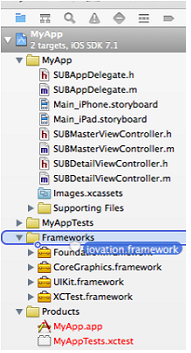
- In the dialog box that appears:
- Select Copy items if needed to copy the framework to your project directory
- Select the checkbox for the targets where you plan to use the framework
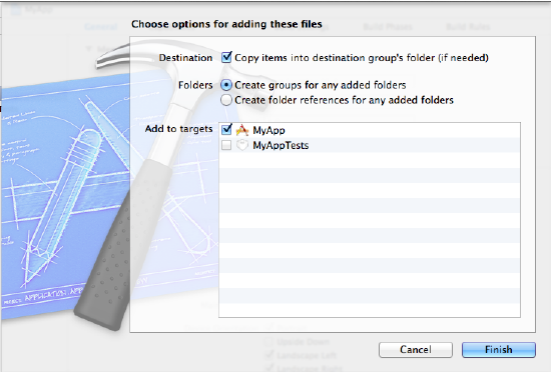
-
Click Finish
-
Add the following frameworks to your app target in XCode:
ExternalAccessory.framework. If you find that Wireless Accessory Configuration is enabled in Xcode 6 or higher and you don't need it, disable and re-add ExternalAccessory.framework
CoreTelephony.framework

- Optionally, add these frameworks if your app uses them:
AdSupport.framework. If your app displays ads
Note: Do not include if your app does not use ads, as the App Store rejects apps that include the framework but do not use ads
CoreLocation.framework. If your app uses location tracking
Note: Do not include unless your app requests geolocation permission from the user
Using the +ioBegin function
A função +ioBegin coleta informações sobre o dispositivo e gera uma caixa preta. Esta caixa preta deverá ser enviada através do campo Customer.BrowserFingerPrint em conjunto com os outros dados para análise.
Syntax
NSSstring * bbox = ioBegin]
**Return
Return values
bbox - string containing the black box
WarningThe black box returned from +ioBegin should never be empty. An empty black box indicates that the protection offered by the system may have been compromised.
Example
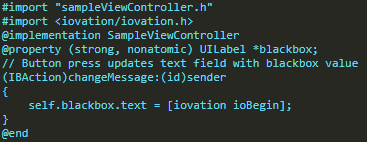
Integrating with Android applications
Android integration files and requirements
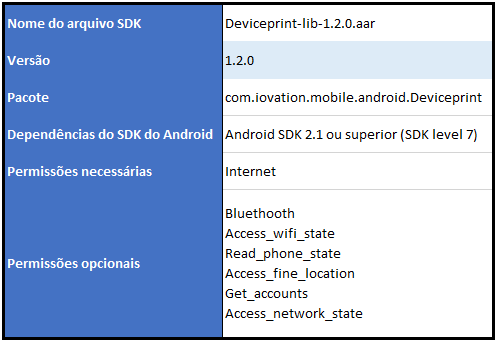
ImportantIf the listed permissions are not needed by the application, the values obtained using these permissions will be ignored. The permissions are not needed to get a black box, but they help to get more information from the device.
Version 1.2.0 of the Iovation Mobile SDK for Android supports Android versions 2.1 and higher.
Installing the SDK on Android
- Download and unzip deviceprint-lib-1.2.0.aar;
- Launch the IDE of your choice;
- In Eclipse and Maven, deploy the .aar extension file to your local Maven repository using maven-deploy. More details at: Maven Guide;
- In Android Studio, select File -> New Module. Expand More Modules and choose Import existing .jar or .aar package;
- Select the deviceprint-lib-1.2.0.aar file, and click Finish;
- Make sure device-lib is a build dependency in your build.gradle file.

Using the ioBegin function
The ioBegin function collects information about the device and generates a black box. This black box should be sent via the Customer.BrowserFingerPrint field along with the other data for analysis.
*Syntax
public static String ioBegin(Context context)
*Parameters
context - an instance of the android.content.Context class used to access information about the device
Return values
string containing the black box
Important
- The black box returned from ioBegin should never be empty. An empty black box indicates that it contains only 0500 and indicates that the protection offered by the system may have been compromised.
- The device-lib-1.2.0.aar file must be packaged with the application.
- Compiling the sample application in Android Studio
- If the option to run the module does not appear, select File -> Project Structure and open the Modules panel. From there, set the Android SDK version in the list.
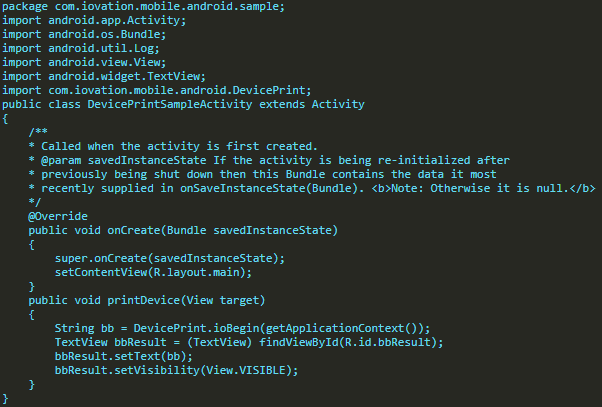
- Download and unzip deviceprint-lib-1.2.0.aar;
- In Android Studio, select File -> Open or click Open Project via the quick-start option;
- In the directory where you unzipped deviceprint-lib-1.2.0.aar, open the sample application's android-studio-sample-app directory;
- Open the DevicePrintSampleActivity file;
- With some configurations, Android Studio may detect an Android Framework in the project and not configure it. In this case, open the Event Log and click Configure;
- A pop-up will open for you to select the Android Framework. Click OK to fix the errors;
- In Android Studio, select File -> New Module. Expand More Modules and choose Import existing .jar or .aar package;
- Select the deviceprint-lib-1.2.0.aar file, and click Finish;
- Make sure device-lib is a build dependency in your build.gradle file;

- Open the DevicePrintSampleActivity folder;
- In the project navigation option, open src/main/java/com/iovation/mobile/android/sample/DevicePrintSampleActivity.java;
- Right-click and select Run DevicePrintSampleAct;
- Select a connected physical device or a virtual Android to run the app;
- The application will compile and run.
The example is simple, there is a button and when clicked a text box is filled with the black box. For a richer example, see the Android Studio sample application included in the SDK.
Updated 2 months ago